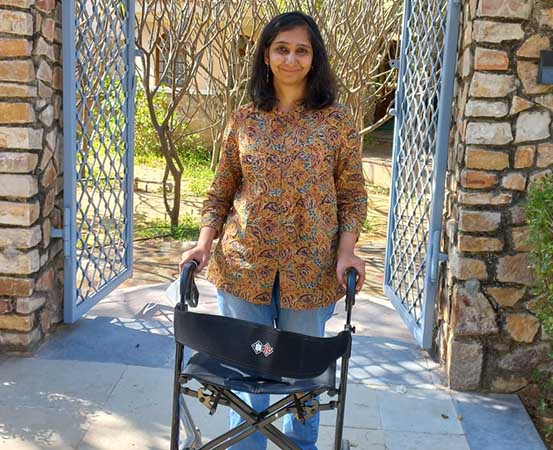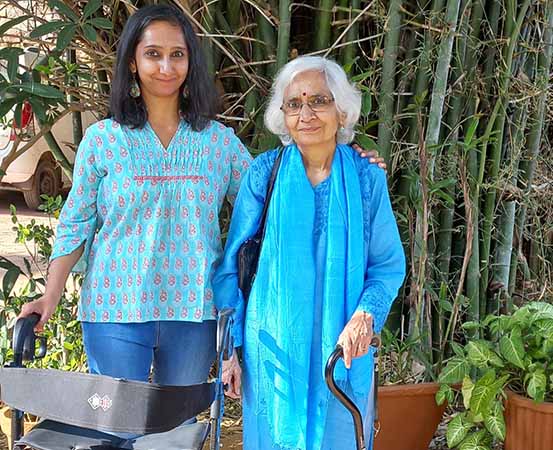
Shilpi Bhattacharya (40), professor at Jindal Global Law School, Haryana, is living with a rare neuromuscular disease called GNE myopathy. However, the thorough academician has not let this condition overpower her zeal for life. Shilpi, who is originally from Delhi, is also a co-founder of World Without GNE myopathy (WWGM), which she started in 2015 along with her parents who are scientists in molecular biology.
WWGM works on connecting people affected with the rare condition and counselling the needy, with an objective that the affected get required treatment, which can only be fuelled by relevant research.
Two years after the onset of symptoms, she was diagnosed with the condition in 2009 while working with a British law firm in Singapore. Speaking to Happiest Health, Shilpi recalled her journey on how she had to be a professional inspite of the condition. Shilpi says that one to six people in a million are born with the condition which affects the entire neuromusculoskeletal structure, causing all skeletal muscles to get weaker over time.
She started experiencing severe symptoms at 24 years of age, while pursuing her Master’s (in law in the US) in 2007. The initial symptoms were difficulty in walking along with gait issues. “I was limping and could not climb steps. I could not run and my walking speed declined,” said Shilpi, who initially mistook it for an orthopaedic issue.
Prior to joining the job, when Shilpi visited her home in India after completing her Master’s, her parents noticed that she wasn’t the same. The doctors she met in India could not figure out what was wrong.
After moving to Singapore, she consulted neurologists. She was first misdiagnosed by a doctor with Charcot-Marie-Tooth, which is a group of inherited disorders that cause nerve damage. “My parents took my reports to All India Institute of Medical Sciences (AIIMS), where it was learnt that the interpretation of results by the doctor was not correct.” Shilpi then consulted another doctor and after one year, she underwent genetic testing and got diagnosed with GNE myopathy in 2009.
At the time of diagnosis, she was able to walk with braces on her feet. “I was leading a very busy professional life as I had a very intense job with long working hours. After diagnosis, I realised that I needed to slow down a little. I then quit my job in Singapore and moved to India. I moved into academia from a law firm.”
Shilpi received the prestigious Erasmus Mundus fellowship when she was pursuing PhD in law and economics. She is focused about her research on competition law, law and economics along with rare disease policy.
Acceptance of the condition takes time, she said. “I was pretty much living my life as if nothing had happened and it took me a while to accept the diagnosis,” she added.
Speaking to Happiest Health, professor Alok Bhattacharya, proud father of Shilpi and co-founder of WWGM, said that she is an ambassador of a debilitating condition. “Accepting the condition is very important and then comes how can one best tackle it. It’s all about one’s mental makeup. Shilpi has been able to contribute to her professional life as well as the organisation. She also runs a WhatsApp group for those affected by GNE myopathy,” said Professor Bhattacharya.

What happens in GNE myopathy?
Shilpi adds that different people have different levels of progression and symptoms are only seen in adulthood. For some, the symptoms could be observed in the legs and for others, it could be observed in the hands. “But mostly, it starts with the distal muscles of the leg, like the ankle. Even siblings with the same mutation can have different symptoms and varying degrees of weakness. “We don’t know why and there isn’t enough study about GNE myopathy,” Shilpi said.
Shilpi recalls that in her case, her fingers were weak since childhood. She always had an issue opening bottles as a child. “In most cases, there won’t be such symptoms in childhood like mine. I could write, but my handwriting was always bad. I had a strange grip on the pen and somehow managed to do it,” she recalled.
The progression of the disease is not that fast, she adds. The prognosis states that within 10-20 years from the diagnosis, the affected part would become completely immobile. “However, in my case, I am still not completely wheelchair-bound. I use a walker. Many people are able to manage their symptoms in a better way than me. I was very career-focused and didn’t really pay as much attention to my health as I should have. People who are more focused about their health receive better outcomes. Now, I try to focus more,” Shilpi said.
Diagnosing GNE myopathy requires genetic testing
A brain MRI may not help in detecting this rare condition as it can be mistaken for muscular dystrophy (genetic disorder that leads to progressive muscle weakness) which also presents with muscle weakness. Only a genetic test provides confirmatory diagnosis.
Research is the need of the hour
At present, there are no medications to treat GNE myopathy and research is still ongoing, says Shilpi. “I do yoga, meditation and stretching exercises. I also take certain supplements and antioxidants.”
The objective of WWGM is to ensure treatment of the condition rather than prevention, as it is difficult. “By the time symptoms appear, the affected individuals could already be married and even have children,” said Shilpi. She recommends genetic testing and counselling for couples who have family members suffering from the condition.
Takeaways
- GNE myopathy, a rare disease which affects the entire neuromusculoskeletal structure, causes all skeletal muscles to get weaker over time.
- Shilpi Bhattacharya, who is affected by the condition, cofounded WWGM along with her parents which connects affected people and fuels research for treatment.
- Currently, there is no treatment for the condition and further research is required in that field.


















2 Responses
Having interacted with Shilpi first hand, I know what an amazing human being and a braveheart she is. I really pray to God that she is able to continue her life with the way she is now, for a very, very long time to come. Shilpi is an inspiration to me and so many others. May God Bless her.
Indeed, she is, and we wish her all the best from our end!